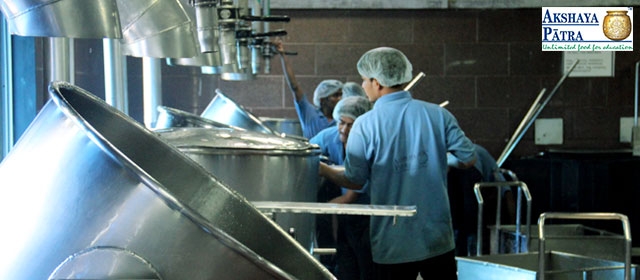The Akshaya Patra kitchen in Hubli has an impressive efficiency rate when it comes to preparing large amounts of meals. As mentioned in the earlier article ‘From traditional to contemporary,’ the Hubli Kitchen is rated as one of the most economical kitchens of Akshaya Patra in India. Like any other kitchens of Akshaya Patra, quality is of utmost importance to the Hubli kitchen. It’s a human inclination to recognise great taste and this kitchen has gone beyond making healthy and nutritious meals for children. The kitchen ensures a meal with a new taste every day. “Any attraction to the food must be its taste. Normally for children, feeding them is a big task. You can imagine how a mother feeds her child, but when children come to school, there is no one to feed them and tell them they have to eat,” explains operations manager, Yagneshwara Dasa. It is the food lab team that makes sure a meal with a different taste is served every day. They carefully formulate a menu keeping in mind that the nutrients in the food should be proportionate.
Ensuring quality at every stage, every day
The quality assurance team at the Hubli kitchen sees that all the quality standards are met. The quality team at the warehouse briefs the vendors on the quality standards. At every stage the ingredients are examined. At the warehouse, the operations team follows a process called first-in and first-out. For example, the potatoes procured by the kitchen are stacked in the warehouse. The first lot of potatoes has to be removed first because if it is kept for too long, it will start decaying. Simultaneously, more goods coming in and overloading will be a problem. “We make sure what came in first is moved out and used. We also have minimum stock levels. For any ingredient, there should be a sufficient stock in the warehouse at all times. The warehouse is stacked with all the materials which are needed for the preparation,” said the operations manager.
The rice to the kitchen is supplied by the Food Corporation of India (FCI). The FCI follows a public distribution system of providing food grains. The dal (lentil, pea or various types of bean) and vegetables are acquired from vendors who follow the safety and health standards set by the kitchen. To avoid monotony, there are 25 recipes of sambar (lentil based curry), with a different dal being used every day. They indulge in sprouting these dals on a weekly basis which makes the food more nutritious. “Surprisingly, the children are very fond of the sprouts and we have received good feedback on this,” Yagneshwara Dasa added.
No insufficiency of food at schools
The team makes certain that there is no scarcity of food at schools. There are 38 different routes to the schools. They find out how many students are absent. Based on these numbers, they calculate the total figure. A cumulative format has an indent for every route. Citing an example, the operations manager said that one route will consist of 25-30 schools. They calculate the number of school children in that particular route. With the help of this format, the team is able to find out the number of students to feed every day. It ensures that no child is left out and some children are able to take food back home happily.
Pushing beyond to reach the isolated areas
The operations team at Hubli is now trying to reach out to more school children especially in remote areas. Several villages surrounding the twin cities of Hubli and Dharwad are sometimes completely cut off during the monsoon. Delivering food to such areas can pose a major challenge. The team is making conscious efforts to reach these areas to feed school children. A hard-hitting fact, mentioned by the operations manager, is that sometimes the Akshaya Patra mid-day meal is the only meal a child has in a day. For this reason, Akshaya Patra is pushing boundaries to reach out to more children and to prevent hunger amongst children and the youth.
Transparency of its operations
To demonstrate transparency and emphasis on quality, the Hubli team organises inspection tours at the kitchen for the school children and teachers. “We want the students and teachers to come see our kitchen. We want to encourage children to eat more and not keep themselves hungry. We also want to show them the standards of hygiene we maintain. It boosts the confidence of the children when they see the food being prepared. And they should understand that we are doing this for them,” the operations manager concluded.







